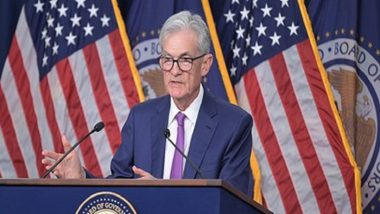New Delhi, September 18: In a departure from the recent monetary policy stance by holding interest rates steady in eight straight meetings, the US Federal Reserve announced a steep 50 basis points interest cut in its latest review meeting. Investors globally were certain that the US central bank would cut rates, but they were looking for the quantum of the cut.
The US Federal reserve monetary policy committee decided to lower the target range for the federal funds rate by 50 basis points to 4.75 to 5.0 percent. US Banks Lose Nearly $190 Billion in Market Value in Past Three Trading Sessions at Stock Market.
"The Committee has gained greater confidence that inflation is moving sustainably toward 2 percent, and judges that the risks to achieving its employment and inflation goals are roughly in balance. The economic outlook is uncertain, and the Committee is attentive to the risks to both sides of its dual mandate," Fed said in its statement.
"In considering additional adjustments to the target range for the federal funds rate, the Committee will carefully assess incoming data, the evolving outlook, and the balance of risks," it added.
Investors across financial markets globally were waiting for fresh cues from the outcomes of the two-day US monetary policy review meeting, particularly the extent of interest rate cut. Federal Reserve Chair Jerome Powell had recently indicated that it was time for the US central bank to reduce interest rates as inflation rates aligned with its target. Indian Market Opens Flat, Cautious Ahead of Fed Rate Cut Decision Tonight; Nifty 50 Drops 16.15 Points, Sensex Down by 42.53 Points.
Addressing the much-awaited Jackson Hole Symposium last month, Powell said that "the time has come for policy to adjust" but stopped short of hinting at the quantum of interest rate cut.
Inflation worries:
Inflation has been a pain point for the policymakers in the US, who wish to bring retail inflation to 2 per cent on a sustainable basis. The silver lining is that the latest inflation data (for August) showed that the inflation rate is steadily moderating towards the intended target.
US inflation fell to 2.5 per cent in August, and is slowing aligning with the intended 2 per cent target. For much of the past three years, inflation ran well above the US central bank's 2 per cent goal, and labour market conditions were extremely tight.
US monetary policy action since Covid pandemic:
Faced with high inflation during the COVID-19 pandemic, the US monetary policy committee raised the policy rate by 425 basis points in 2022 and another 100 basis points in 2023 as part of its commitment to restoring price stability.
It held the policy rate at its current restrictive level since July 2023, in eight straight review meetings. During the COVID-19 pandemic, the interest rates were near zero.
Raising interest rates is a monetary policy instrument that typically helps suppress demand in the economy, thereby helping the inflation rate decline.
Fed policy impact on stocks in India:
Foreign portfolio investors seemed to have upped their investments in India, hoping for a better return on investments with high chances of interest rate cuts in the US. FPIs have been net buyers here in India.
Domestic stock indices had been rising substantially of late, possibly due to inherent strength in domestic market fundamentals. Indian markets surged strongly this week, reclaiming record highs. Loosening monetary policy in the US through rate cuts typically leads to flight of capital to markets where policy rates are high. The steeper the rate cut in the US, the more is the tendency of flight of capitals to alternative investment destinations, including India.
It is to be seen how Indian stocks react to the Fed outcome, when the market bell rings Thursday morning. On Wednesday, Sensex and Nifty closed marginally lower, as investors awaited Fed announcements.
(This is an unedited and auto-generated story from Syndicated News feed, LatestLY Staff may not have modified or edited the content body)













 Quickly
Quickly





















